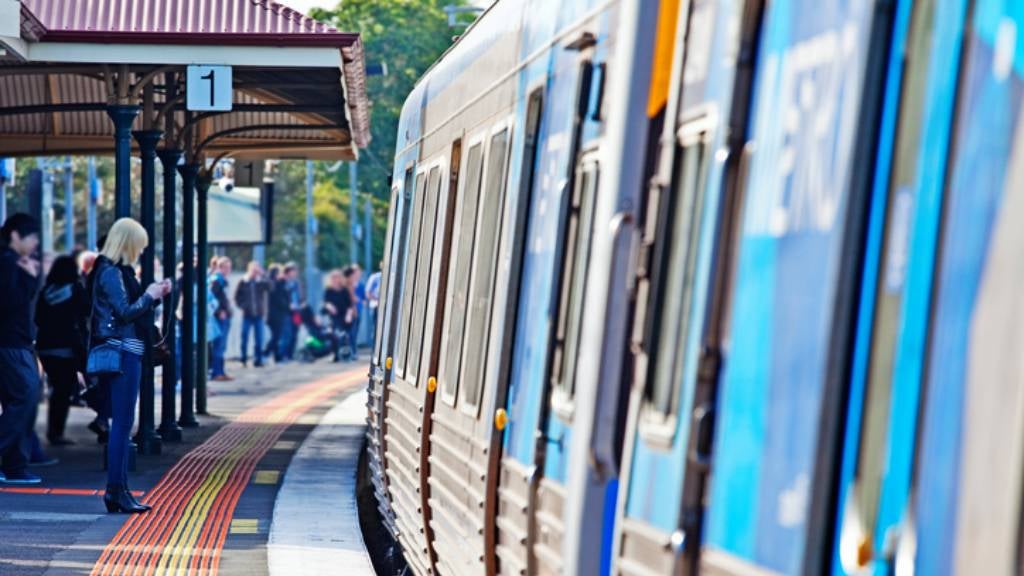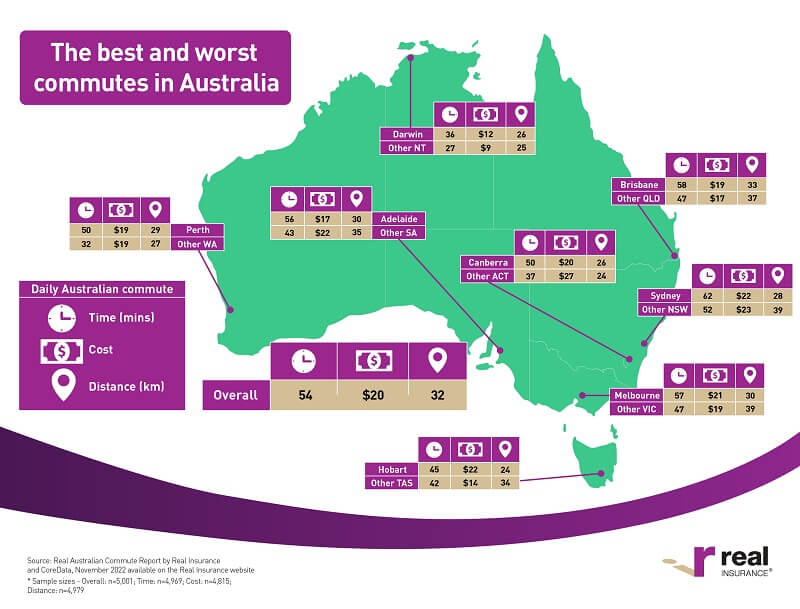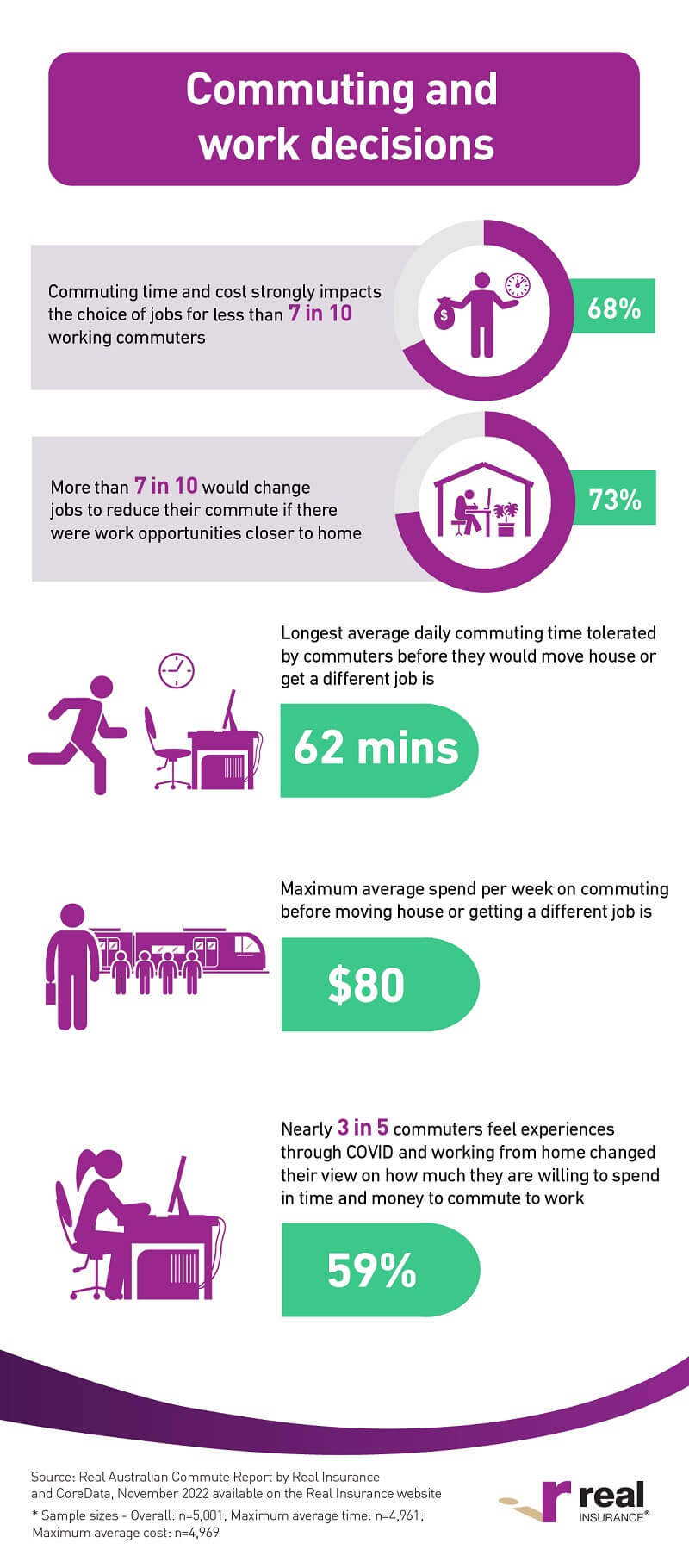The Real Australian Commute Report 2022

16 Nov 2022
The commute is back – and the cost of commuting is high
After two years of working from home – at least to some extent – 2022 has signalled the return to the office, and with it, the return of the commute. Whether by bus, train, tram, ferry or car, Australians have been hitting the roads (train tracks and seas!) to get to work again.
Australians are spending a lot of time commuting, on average 54 minutes per day and roughly 169 hours per year! That’s time that you could spend with family or catching up with friends!
But with many Australians now accustomed to new ways of working, do they still have the same attitudes towards the commute? Are they still willing to travel every day and spend their precious time on the roads? And what about the accompanied costs of commuting to work, such as petrol, tolls, or public transport, especially considering the rising cost of living?
Australians may not be able to control their work commute conditions. However, they can control certain parts of their life such as protecting the lifestyle they’ve worked so hard to build with Real life insurance.
The Real Australian Commute Report 2022 continues the research from the 2016 Australian Commuter Survey and is the latest edition in the Real Insurance research series. This report explores the key aspects of commuting in Australia – tackling costs, time and distance commuted by Aussies, and the impact this has on work and living preferences in today’s post-pandemic landscape.
Cost of commuting has never felt more expensive
With inflation and rising cost of living concerns, the research suggests that commuting costs are beginning to trouble Aussies’ personal finances.
Across the nation, the average daily cost of commuting is $20, which totals a whopping $4,003 per year. The report suggests that collectively, Australians spend $43.2 billion annually on their commute to work. That’s a lot of money, and with rising financial concerns and a potentially looming recession, it’s not surprising to hear that most commuters surveyed (85%) agree the government could do more to ease the costs of their daily commute.
The Real Concerns Index 2022 discloses that 52% of individuals reported concerns relating to inflexible work environments, and 48% reported problems with work-life balance and children’s needs.
According to the Real Australian Commute Report 2022, commuters (83%) agree that the journey to work has never felt as expensive as it is now. Unfortunately, nearly half (47%) said the increased costs have put considerable financial pressure on their household.
With commuting costs continuing to climb and household budgets under pressure, it’s more important than ever to have a financial safety net in place. At Real Insurance, we offer life insurance, income protection, and funeral insurance options to help Australians stay financially secure, no matter what life (or the daily commute) throws their way.

In most states, citizens of capital cities appear to be spending more than their regional neighbours. Regional ACT commuters are one of the exceptions, recording the highest commute costs across the nation with the average commuter forking out $27 per day (vs. $20 for inner city Canberra commuters), followed by regional NSW commuters spending $23 per day.
Interestingly, while Sydney and Hobart are the most expensive capital cities for commuting ($22 per day), commuters in Brisbane were most likely to describe their trip as difficult (29%), especially compared to cities like Darwin (6%).
You can see how your commute compares here.

Public transport issues: We like public transport, without the ‘public’
Someone jumps the bus queue in front of you, a smelly person sits right next to you, someone takes up too many seats, or talks loudly on their phone disrupting everyone around them – we’ve all been there. Unless you’re a tolerant person, these behaviours can get to you. In fact, most mass transit commuters (78%) believe that commuters with bad manners should be fined or even banned from using public transport.
Most mass transit commuters (87%) wish that our fellow commuters on public transport had better manners and wish that commuters were friendlier to each other (83%).
Australia: the land of bad-mannered drivers?
But it’s not only public transport users who are feeling frustrated about their journey; most car commuters surveyed agree that other drivers should have better knowledge of the road rules (91%), and that too many drivers and road users are not courteous or safe (85%). Similarly, many also believe that bad drivers should be fined or banned from using the roads (87%).

There is no question that Aussie habits and concerns have changed since the COVID-19 pandemic hit. Although the cost of commuting varies across Australia, it’s clear that regardless of the method of transport, Australian’s are certainly feeling the pinch of the cost of their commute.
How do you decide to commute to work?
The past few years have given many Australians the opportunity to ditch their commute and work primarily from home by adapting new ways of working.
Through their experiences with COVID-19 and working from home, many commuters (59%) have changed their view on how much time and money they are willing to spend to get to work.
And with HR departments struggling to fill positions, job seekers seem to be spoiled for choice. So, why take a job that requires a long and costly commute?
Indeed, the research shows that many commuters (68%) agree that travel time and costs strongly impact their choice of job and work location, with nearly 3 in 4 (73%) agreeing that they would change jobs if there were work opportunities closer to home.
Despite the return to the office, the situation looks significantly different compared to pre-pandemic times. The full-time return to office has been reportedly slow, especially in major cities. In fact, just over half of respondents (51%) cited they are still working remotely or from home at least sometimes.
The maximum commuters are willing to spend per week commuting to work – before they would consider moving house or changing jobs – is $80 on average, while the longest time they are prepared to spend on a daily round trip before considering moving or changing jobs is 62 minutes on average.
Work location preferences are divided; however, most commuters prefer some degree of hybrid work (59%). Only a small percentage (7%) would prefer to work from home exclusively, while a third (34%) prefer to work entirely from the office.

The ‘city-exodus’ reverse
Where we live has a huge impact on many aspects of our lives. How close we are to family, friends, shops, schools, the beach or nature can be key considerations for Australians when choosing a place to live. The transition to working from home during the pandemic saw some Australians move away from the city, opting for a sea (or tree) change. And whilst the majority of those are happy with the decision they made to move to a coastal, regional, or rural area (94%), a large proportion (68%) are planning to move back, with over 1 in 3 (36%) already in the process of making this change.
The reasons for moving back were varied between these ‘city-cravers’, however many of them were missing their friends and family (44%), chasing better work opportunities (42%), or missing their old lifestyle (37%).
The green commute: Eco-friendly travel
In the face of rising inflation and climate concerns, Australians also want to take steps to help the environment.
However, while protecting the planet is important to Australians, low running costs (42%) and good performance (39%) received more ratings of extreme importance than environmental friendliness (21%) when purchasing a car.
Despite the results indicating that Australian commuters are more likely to view low running costs and good performance as extremely important, environmental friendliness remains relevant as a few early adopters (10%) already own an environmentally friendly car, with another 2 in 5 (42%) considering purchasing an electric or hybrid vehicle as their next car.
Interestingly, females are less likely to want or own an environmentally friendly car (60% men vs 46% of females). Additionally, younger generations are slightly more likely to want an environmentally friendly car as their next car compared to older generations: Gen Z (46%), Gen Y (45%), Gen X (39%), Baby Boomers (35%).
Additionally, many commuters (75%) feel that the government should be doing more to encourage the transition to environmentally friendly cars.
The above information has been sourced from The Real Australian Commute Report 2022.